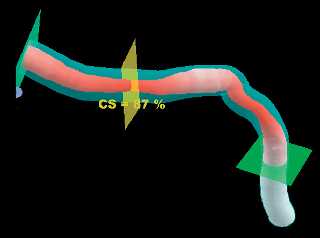| Cardiology, diagnostic imaging | |
Siemens interventional cardiac technology provides 3D visualisation of coronary vessels24 September 2005 Siemens Medical Solutions has introduced Interventional Cardiac 3D (IC3D) technology to create three dimensional (3D) angiography images of the coronary vessels in the heart. The introduction of IC3D technology will provide clinicians with an extremely helpful and important tool in the evaluation of patients prior to stenosis. With this technology, Siemens is leading the way to better patient care overall, making procedures effective, while enhancing workflow and cost efficiencies for the hospital.
When paired with an AXIOM Artis imaging system from Siemens, IC3D allows cardiologists to view the coronaries in 3D with as few as two images, leading to great precision in determining appropriate stent size and length, faster examination times, the use of less contrast medium and lower radiation dosages. "The IC3D technology has definitely enhanced digital imaging by allowing cardiologists to view 3D images of coronary and peripheral arteries, helping to achieve optimal diagnostic and interventional outcomes for our patients," said Neal Kleiman, Medical Director of the catheterisation lab at the Methodist DeBakey Heart Centre in Houston. "The system has proven to be an excellent tool for quality patient evaluation and accurate determination of appropriate stent size and placement." According to the American Heart Association, there is an approximate 25 per cent chance that patients will need additional procedures to correct re-stenosis, or repeat narrowing of a coronary artery treated with a stent. During initial stenosis, the physician's ability to select and place the appropriate stent is crucial in order to avoid re-stenosis in the following months and years. With 3D visualisation of the coronary vessels, clinicians can see the artery and the stenosis accurately and can therefore size and place the stent precisely and effectively. Such efficient use of technology is likely to prevent patients from needing to repeat invasive and often costly procedures. The Methodist Hospital in Houston performs about 3000 coronary and peripheral interventions annually: "I would say we are using IC3D about 70 or 80% of the time", said Kleiman. Combining IC3D with technologies in the AXIOM Artis platform provides users with an enhancement to the features already available on other AXIOM Artis technologies. These advantages include superior image quality, ease of use, maximum radiation protection and optimal system connectivity. Additionally, since the technologies are equipped with syngo, Siemens' standard user interface, all patient data can be seamlessly shared. This enables physicians to create a comprehensive patient report during the exam, including stored reference images and allows completion of the patient report after finishing the procedure. A dynamic presentation of the technology is available on the website www.siemens.co.uk/medica
|
 Figure.
Interventional Cardiac 3D technology provides clinicians with a helpful and
important tool in the evaluation of patients prior to stenosis.
Figure.
Interventional Cardiac 3D technology provides clinicians with a helpful and
important tool in the evaluation of patients prior to stenosis.